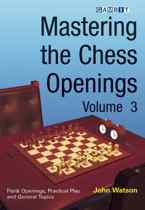Mastering the Chess Openings — Volume 3
John Watson

IM John Watson of Lincoln, Nebraska, is on a short list of the best chess writers in the world. For three decades he has written insightful, well-researched books on all aspects of the games especially middlegame strategy and openings. The first books to bring his name to the attention of the general chess public were a four volume series on the English Opening in the late 1970s and early 1980s. His newest work completes the circle as the third volume of Mastering The Chess Openings is completely devoted to 1.c4.
Fans of Watsons two earlier works in the series are certain to be pleased with his latest effort. While theory has built up on 1.c4, it is nowhere near as voluminous as 1.e4 and 1.d4, enabling Watson to offer more complete coverage. The present covers 1.c4 e5, 1.c4 c5 and 1.c4 Nf6. The only variation I could find that was not covered but normally is in a work on the English was the Double Fianchetto line in the Symmetrical English (1.c4 c5 2.Nf3 Nf6 3.g3 b6 4.Bg2 Bb7 5.Nc3 g6) which is no doubt intended for the fourth and final volume in this series on the Reti and various other flank openings.
A good writer on the English has to be aware of the transpositional possibilities, especially in the Symmetrical variation. Watson is more than up to the task by pointing out the pros and cons of the Reversed Dragon Sicilian (1.c4 e5 2.Nc3 Nf6 3.g3 d5 4.cxd5 Nxd5 5.Bg2 Nb6) which would seemingly favor White but where in fact chances are equal as Blacks “extra information he moves second counterbalances the advantage of the first move. Watson clearly explains how getting to see Whites intentions helps Black adopt the correct plan.
I was aware of the idea 1.c4 c5 2.Nc3 Nc6 3.g3 g6 4.Bg2 Bg7 5.Nf3 e5 6.d3 d6 7.Nd2 intending Nf1-e3 (as opposed to Nf3-e1-c2-e3) but had never thought of 1.c4 c5 2.Nc3 Nc6 3.g3 g6 4.Bg2 Bg7 5.e4 d6 6.Nge2 Nf6 7.0-0 Nd7 8.d3 Nf8. This accelerated desire to control d4 intercepts the plan of d3, Be3 and d4 suggests White should not be in a hurry to castle. Nor did I realize that 1.c4 c5 2.Nc3 Nf6 3.g3 d5 4.cxd5 Nxd5 5.Bg2 Nc7 6.Qb3 Nc6 7.Bxc6+ bxc6 8.Qa4 is the same as 1.c4 c5 2.Nf3 Nc6 3.Nf3 g6 4.d4 cxd4 5.Nxd4 Bg7 6.Nc2 Bxc3+ 7.bxc3 Qa5 the first move being mitigated by taking two moves to reach a4 with the Queen.
Watson has not confined himself to just explaining the ideas behind the English or its many transpositional possibilities. Like all of his other books, this one challenges the traditional standards. I had always been under the impression that after 1.c4 c5 2.Nc3 Nc6 3.g3 g6 4.Bg2 Bg7 the normal looking move 5.Nf3 was a sort of high level mistake in that it allowed Black to break the symmetry with either 5…a6, 5…e5 and especially 5…e6. Conventional wisdom to my mind was that after the latter White could either try a somewhat suspicious gambit with 6.d4 or try for a quick draw with e3 and d4. Supposedly quieter play with 0-0 and d3 followed by Bd2 and Qc1 was asking to be squeezed see Fischers win over Petrosian from their mini-match during the USSR- Rest of the World clash of titans. Watson does not agree! He feels Petrosian only went wrong in the middle game and had he played 21.Nbd3 the position was up for grabs. He then shows how throwing in Bg5 and only playing Bd2 after …h6 may win White a tempo when he plays a later Qc1.
Mastering The Chess Openings is not a pure opening book on the English as we presently know it for example you will find no coverage of 1.c4 c5 2.Nc3 Nc6 3.g3 g6 4.Bg2 Bg7 5.Nf3 a6 but in many ways it goes beyond what we expect as Watson essentially explains the opening from the ground up with detailed discussions on move two and three in certain lines.
Watson writes that he aimed this book for a wide range from a “low-rated player with say, one or two years experience, to a long-time player who is familiar with a good deal of theory. I am not sure if this is possible but would say that it is definitely must reading for anyone rated 2000 on up who has any interest in the English or modern chess.
Highly Recommended!
Also check out the reviews for Mastering The Chess Openings: Volume 1, Mastering The Chess Openings: Volume 2, and Mastering The Chess Openings: Volume 4.
